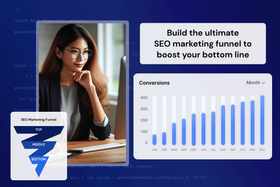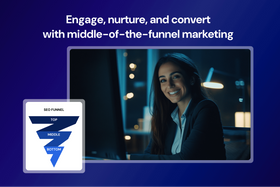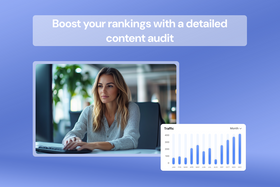5 stages of the user journey: A guide to nurturing leads through each step
Learn the different stages of the user journey to effectively engage with your audience and turn every touchpoint into an opportunity for growth.
Updated March 27, 2025

You need to understand the different stages of the user journey to engage with your audience and optimize for conversions. After all, the user journey is more than a series of steps; it's the foundation that shapes your entire business. By mapping and understanding each stage, you can deliver value at every touchpoint and tailor your content and overall user experience to meet your audience's needs. In this article, I'll break down the key stages of the user journey and explain how to master them.
Key takeaways
- The user journey has five stages: awareness, consideration, decision, retention, and advocacy.
- Understanding each stage is crucial for delivering value at every touchpoint and optimizing the overall user experience.
- Every stage has unique requirements and demands a tailored approach to effectively engage and guide users.
- Supporting every stage of the journey ensures a smoother path through your sales funnel, leading to better conversions and reduced churn.
What is the user journey?
The user journey refers to the path a user takes to achieve a specific goal on your website, such as making a purchase, signing up for a newsletter, or simply finding information. It typically consists of five stages (awareness, consideration, decision, retention, and advocacy) and involves several touchpoints across multiple channels. You can also further divide these five stages and their respective touchpoints into three categories: pre-purchase (awareness and consideration), purchase (decision), and post-purchase (retention and advocacy).
Before we examine each stage more closely, let's look at an example of what a user journey for a running app may be like:
- Awareness: Lilly, a casual runner, searches online for tips on improving her endurance. One article recommends using RunSmart, a running app designed to monitor and enhance performance.
- Consideration: She visits several websites to compare features like personalized training plans and smartwatch integration. She reads user reviews and watches demo videos to see how RunSmart stacks up against other apps.
- Decision: Lilly decides to download RunSmart because of its free trial and robust community features. She signs up easily and sets up a personalized running plan.
- Retention: She becomes an active user, enjoying weekly progress reports and engaging challenges. Being able to interact with other runners keeps her committed to the app.
- Advocacy: After achieving her running goals, Lilly shares her success on social media, tags RunSmart, and leaves a positive review. The app rewards her with a badge, further strengthening her loyalty and encouraging her to recommend it to others.
In this example, Lilly interacts with ten touchpoints across six channels throughout her journey, but not all user journeys are this straightforward. Users don't always follow these stages in order and may interact with many more touchpoints and channels before taking a desired action.
5 stages of the user journey
Now that you have a better understanding of the user journey, let's take a look at each stage in more detail.
1. Awareness
The awareness stage is the first step of the user journey, where users become aware of a product, service, or brand. This awareness can happen passively, such as when users see an advertisement or social media post, or actively when they recognize a problem and start searching for a solution.
At this stage, users are often trying to understand their needs better and explore possible solutions, but they aren't ready to make a purchase yet. Their primary goal is to gather information.
Typical touchpoints in the awareness stage include:
- Informational videos and blog posts
- Paid search ads
- Landing pages
- Social media posts and ads
- Email marketing campaigns
- Word-of-mouth referrals or recommendations
» Guide users from awareness to decision with Entail CRO.
2. Consideration
The consideration stage occurs once the user is aware of potential solutions to their problems and begins to compare different options. At this stage, the user is more informed and actively evaluating various products, services, or brands to determine which best meets their needs.
During the consideration stage, the user's main goal is to gather enough information to make an informed decision. They may compare features, benefits, and pricing between brands, read product reviews, and look for recommendations from influencers or other trusted sources. The user is focused on finding the solution that offers the best value, fits their specific requirements, and aligns with their preferences. This stage is where the user starts to form a preference, making it essential for you to present your offerings clearly and compellingly.
Key touchpoints in the consideration stage include:
- Product pages, guides, and comparisons
- Demos and tutorials
- Product videos
- Pricing pages
- Customer reviews and success stories
- Discovery and consultation calls
» Book a demo to find out how you can optimize every user journey across your site automatically.
3. Decision
Once they reach the decision stage, users are ready to complete their goals, whether that's making a purchase, signing up for a service, or downloading an app. The user has already compared their options and decided on the best solution. Now, they're focused on executing their decision smoothly and efficiently.
The buying experience at this stage is crucial, as any friction can cause the user to reconsider or abandon their decision. During the decision stage, users expect the process to be easy, with clear instructions and minimal steps.
Key touchpoints in the decision stage will vary depending on the product or service you offer, but they generally include:
- Product pages
- Point of sale (e.g., e-commerce checkout page, a sign-up form, or a booking system)
- Customer support or live chat
- Customer success programs
4. Retention
At the retention stage of the user journey, brands must focus on maintaining and improving their relationship with the customer after they've completed their goal. Retaining an existing customer is significantly more cost-effective than acquiring a new one, making this stage crucial for long-term success. Satisfied customers are more likely to become loyal customers, and customer loyalty not only reduces churn but also boosts profitability by encouraging repeat purchases and advocacy.
At this stage, you need to leave a lasting positive impression that encourages customers to continue engaging with your products or services. Customers who have had a good experience are less likely to switch to a competitor, so ensuring they consistently receive value and support is important. This requires actively nurturing the relationship and finding ways to exceed customer expectations.
Key touchpoints in the retention stage include:
- Feedback surveys
- Customer onboarding and support
- Email newsletters
- Upselling and cross-selling emails
- Self-service resources (e.g., company knowledge base or FAQs)
- Community forums
» Optimize customer journeys across your site with customer journey mapping.
5. Advocacy
The advocacy stage of the user journey is where satisfied customers become brand advocates who promote your products or services to their friends, family, colleagues, or social media followers. This stage is crucial because word-of-mouth recommendations are incredibly powerful—88% of people trust recommendations from people they know over any other channel. Plus, once customers are loyal to a brand, 59% of consumers say they remain loyal for life. So, turning satisfied customers into advocates strengthens their ongoing relationship with your brand and helps attract new customers.
Users at this stage share their positive experiences and successes with your product or service. They may take pride in finding a solution that works for them and are eager to recommend it to others. By continuing to engage these users and recognizing their loyalty, brands can further encourage advocacy.
Key touchpoints in the advocacy stage include:
- Loyalty programs and rewards
- Referral and affiliate programs
- Personalized offers and incentives
- Partnerships
- User-generated content (e.g., reviews, testimonials, or social media posts)
- Exclusive events or webinars
How to improve each stage of the user journey
Having a firm grasp on every stage of the user journey is essential, but you also need to ensure each one is hitting the mark. Here are a few strategies to help you fine-tune each stage and ensure your efforts lead to success.
Get to know your users
Improving the user journey starts with a deep understanding of who your customers are and what they need. Put yourself in their shoes—think like your customers and anticipate their expectations at every stage of their journey. Find out who your customers are, including their demographics, preferences, and behaviors, and understand their goals and challenges. Then, look at all the touchpoints from their perspective and consider how they interact with your brand across various channels.
Map the user journey
User journey mapping is a crucial step in understanding, connecting with, and ultimately converting users. A user journey map tracks key elements such as how users find your brand, the actions they perform on your site, their emotions throughout the process, what convinces them to take action, and any issues they encounter. With these insights, you can map out various journeys that utilize different touchpoints. The purpose of this map is to identify and eliminate weak points in the user journey, allowing you to optimize each interaction and enhance the overall user experience for a smoother and more effective path from awareness to conversion and beyond.
» Chat with us to start tracking and optimizing user journeys across your site.
Create content for each stage of the user journey
By aligning your content with the needs and expectations of users at different stages of the user journey, you enhance their experience, make your marketing efforts more effective, and drive better engagement and higher conversions. Personalized and contextualized messaging ensures that your content stays relevant and impactful, regardless of where users are in their journey. Whether they're just becoming aware of your brand or are on the verge of making a purchase, the content at each touchpoint should address users' needs and intent to guide them further down your sales funnel.
» Guide customers with user journey content marketing strategies tailored to each stage.
Optimize user journeys across your site
To guide users through your SEO conversion funnel, you need to optimize the user journey. Start by tracking and analyzing the different user journeys on your site. That way, you can strategically incorporate widgets and CTAs that align with each page's context, intent, and user journey stage. However, tracking so many user journeys can be a significant challenge. Entail CRO simplifies the entire process by automatically creating relevant CTAs for each section of every page on your site, leading to a higher click-through rate, reduced churn, and maximized conversion rates.
Refine every user journey stage to boost growth
Understanding the different stages of the user journey is your key to creating experiences that resonate, retain, and inspire loyalty, ultimately driving your business to new heights. When you can pinpoint where users encounter friction, you can fix those issues before they derail a potential conversion. You turn passive users into loyal advocates by strategically supporting the user journey at every stage. By optimizing each stage and touchpoint, you get smoother paths to conversion, higher satisfaction rates, and a brand experience that users can't help but share. The question isn't if you should start refining your user journey; it's how much growth you're willing to unlock by doing so.
» Book a demo to see Entail's CRO software in action, or try it for free.




